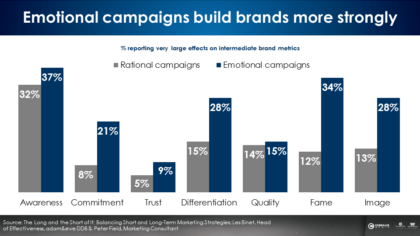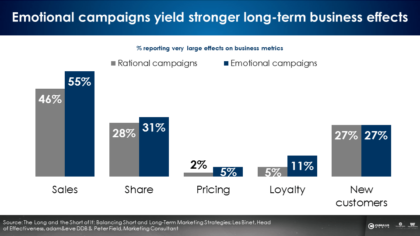When you’re producing creative for a brand or campaign, it’s a cardinal sin to be boring. The first job of any creative output is to capture the attention of the intended audience. If you fail to do that, everything else is moot.
Whilst there are more obvious creative pathways for businesses that sell beer or holidays, what if your organisation errs on the less…extroverted side of the spectrum? In other words, how do you make ‘boring’ things, not?
B2B or B2C? That isn’t the question
From a creative perspective there are no tangible differences between producing work for B2B or B2C organisations. Yes, the buying cycles are different and yes, the ‘messy middle’ is decidedly messier when the audience is weighing-up multi-million pound contracts; however, creatively speaking, the goals remain the same: Grab attention., engage effectively, and be remembered.
Or, to be even more succinct and combine all three of those things together, be remarkable.
Stop talking about yourself
Where a lot of B2B — and in particular SaaS brands’ — creative fails is in thinking that your audience is only interested in hearing about what features your product offers. The problem here is both simple and obvious: everyone is saying the same thing.
If both you and your competitor are putting artwork in front of a prospective customer that extols the virtues of your respective products, you run the risk of becoming white noise. Completely indiscernible from one another and—even worse—boring.
It’s the equivalent of trying to strike up a conversation by only talking about yourself. So, rather than risk becoming a perennial bore, what should you do instead?
Understand your audience
It should go without saying really, but you need to be able to read the room. You need to know what kind of problems your audience has, what they respond well to (and what they respond badly to) in order to best understand what approach to take.
This means asking questions instead of just talking about yourself. Find out what makes your prospects tick and then start thinking of ideas that will pique their interest. Set the foundation for what comes next.
Buyers call the shots and competition is high, particularly in fast-moving markets where customers often shop around. Investing in customer research is an important first step in understanding the problems you can solve for them and how you can communicate this.
Engage with emotion
It shouldn’t matter if you’re selling beer or accounting software; both of those things can elicit an emotional response from their intended audiences, and that’s how you should approach your creative output.
Beer can be tasty and uplifting. Accounting software can make sense of an indescribably frustrating experience—providing the kind of psychological relief that, arguably, warrants its own specific term in the dictionary. So, don’t wax lyrical about all the fancy features your software has to offer and instead focus on describing that feeling.
Better yet, don’t just describe it. Show it. Paint a picture of it. Encapsulate it in a clever line of copy. Immortalise it in an epic video. Whatever you do, make sure it’s rooted in emotion. It’s been long understood in marketing that a consumer’s emotional response to a creative has a far greater influence on their reported intent to buy a product than its content.

Tell stories
Storytelling has been present throughout the entire history of the human species. There’s a reason we’ve found cave paintings that’re thousands of years old, and it’s because storytelling works.
It’s no different for your creatives either. What if you tell the story of how insanely complicated the world of accountancy is? What if you purposely accentuate that complexity to get your point across? And now what if you introduce a new way? A better way. Your way. Suddenly you shift from droning on and on about the features of your software into an exciting, engaging story where your product is the hero. That feels more remarkable than ticking boxes.
Do it right, and it can yield long-term business growth as well as short-term gains.

But, that being said…
Do still talk about your features. All of those details are still important, just not in your first impression. Your prospective customer still has a big decision to make, so they’ll need to know about your offering and how it stacks up against your competitors — but let them find that out once they’ve warmed up to you a little bit, first.
Once you can comfortably call them an acquaintance, that’s when you can start talking more about your all-round brilliant self. Not so boring anymore, eh?
Ready to upscale your marketing?
Our team of designers and copywriters can help you elevate your creatives to the next level. Let’s talk.






